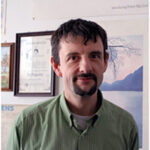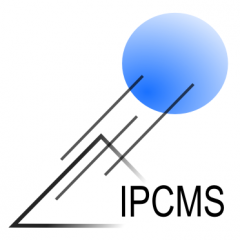
Higher Education & Employment
- 1996 to present: Materials Science Engineer at the Department of Organic Materials of IPCMS
- 1995-2: Post-doctoral researcher at the University of Sheffield (UK), topic “Synthesis of ionic Liquid Crystals”
- 1995-1: Post-doctoral researcher at IPCMS, topic “Study of discotic Liquid Crystals“
- 1994: Post-doctoral researcher at the Technical University of Berlin (Germany), topic “Synthesis of discotic Liquid Crystals“
- 1989 to 1993: PhD in Physical Chemistry at the University of Strasbourg, dissertation title “Study of structure and mesomorphic properties of homologous series and mixtures of smectogenic compounds“
Research & Engineering activities
- Research topic: elucidation of the mechanisms of molecular self-assembly controlling the structure of materials and elaboration of methodologies of molecular design
- Research field: molecular, polymeric and hybrid organic-inorganic materials, in bulk state and processed as thin films for device applications
- Core activity: study of the structure, self-assembly and morphology of materials, and of their impact on material properties
- Scientific Expertise: materials science, soft matter, mesomorphism, crystallography, structure modeling, phase transitions, thin films
- Engineering Skills: data analysis, software development, design of experiments and of experimental set-ups, instrumentation & measurements
- Main experimental techniques: X-ray scattering/diffraction at laboratory scale and at synchrotron, thermal analysis, optical microscopy
Scientific networks
- Member of the consortium STELORG “Strasbourg Électronique Organique” associating 4 local research institutes (https://stelorg.unistra.fr/)
- Scientific and technical partner of the platform MICASOL “Plateforme de haute-technologie sur synchrotron soleil pour l’étude de la structure et du comportement des matériaux, de l’échelle moléculaire et nanométrique à l’échelle mésoscopique et macroscopique” associating the synchrotron SOLEIL, 3 local research institutes and 2 local universities (https://www.ics-cnrs.unistra.fr/micasol/)
- Partner of the International Research Project (IRP) LUX ERIT “Organic semiconductors and light-emitters for optoelectronics and photonics” associating the research center OPERA of Kyushu University (Japan) and 4 French research institutes
- Former member of the SOLEIL Synchrotron Peer Review Committee №4 “Chemistry & Physico-Chemistry, In situ Reactivity, Soft Matter” (2017 – 2024) and chairperson of the subcommittee “Soft Matter“ (2019 – 2024).
- Member of the editorial board of the journal “Crystals” of the MDPI group (since 2017)
- Member of reviewer boards of journals of the RSC, MPDI and Elsevier groups
Research contracts
- Scientific leader of the IPCMS partnership and leader of the task “Structural and morphological studies of materials and films” in the ANR contract MESOMORPHICS “Mesomorph polyoxometalate-based hybrids materials for photonics“, coordinated by the Institut Parisien de Chimie Moléculaire (IPCM, Paris) (duration: 12/2020 to 11/2025)
- Leader of the subtask 2.2 “Characterization of the materials’ organization” in the ANR contract TRIPODE “Tri-segmented side chain conjugated POlymers for fine-tuning the performance of Doped organic Electronics“, coordinated by IPCMS (duration: 05/2024 to 10/2027)
Publication metrics
238 co-authored articles in peer-reviewed journals, ~6500 citations, H-Index = 40 (Web of Science at 15th January 2024) ORCID: https://orcid.org/0000-0001-6795-2733
Selected research achievements
- Liu, X.; Placide, V.; Chu, L.; Mall Haidaraly, K.; Sosa Vargas, L.; Adachi, C.; Wu, J. W.; Heinrich, B.; Lacaze, E.; Yan, W.; D’Aléo, A.; Mathevet, F. “Investigation and modulation of charge transport properties with thin films of an isoindigo-based donor-acceptor molecular semiconductor”, Applied Surface Science, 2025, 686, 162057. Achievements: resolution of the structure, modeling of the molecular self-assembly and characterization of the thin film morphologies. Understanding the evolution of charge transport performances as a function of conditions of film fabrication.
- Kékicheff, P.; Heinrich, B.; Hemmerle, A.; Fontaine, P.; Lambour, C.; Beyer, N.; Favier, D.; Egele, A.; Emelyanenko, K. A.; Modin, E.; Emelyanenko, A. M., Boinovich*, L. B. “Condensation or Desublimation: Nanolevel Structural Look on Two Frost Formation Pathways on Surfaces with Different Wettabilities”, ACS Nano, 2024, 18, 15067–15083. Achievements: through the development of a specific atmospheric chamber, the mechanisms of frost formation were investigated in situ by GIWAXS as a function of surface wettability, temperature and relative humidity of air atmosphere.
- Ślęczkowski, P.; Xiao, Y.; Wu, J. W.; Adachi, C.; Sosa Vargas, L.; Kreher, D.; Heinrich, B.; Ribierre, J.-C.; Mathevet, F. “Electron Transport in Soft-Crystalline Thin Films of Perylene Diimide Substituted with Swallow-Tail Terminal Alkyl Chains”, J. Phys. Chem. C, 2024, 128, 21826-21835. Achievements: elucidation of the original soft-crystalline structure and molecular self-assembly of a reference molecular semiconductor through the combination of dilatometry (variable-temperature density measurement) and X-ray scattering on bulk and thin films. Understanding of the different charge transport performances determined for films deposited with different techniques.
- Matsushima, T.; Qin, C.; Teng, T.; Kamatham, N.; Sosa Vargas, L.; Kreher, D.; Heinrich, B.; Ishii, T.; Terakawa, S.; Leyden, M. R.; Sandanayaka, A. S. D.; Bencheikh, F.; Miyata, K.; Onda, K.; Kanemitsu, Y.; Mathevet, F.; Adachi, C. “Efficient Electroluminescence from Organic Fluorophore-Containing Perovskite Films”, Adv. Mater., 2024, 36, 2408775. Achievements: elucidation of the thin film structure and morphology of a two dimensional perovskite containing an organic fluorophore, and of their relation with device performances.
- Brouillac, C.; Serez, A.; McIntosh, N; Rault-Berthelot, J.; Jeannin, O.; Heinrich, B.; Quinton, C.; De Sagazan, O.; Jacques, E.; Cornil, J.; Poriel, C. “Importance of the curvature in electronic, structural and charge transport properties: oligomers of N-pyridine carbazole”, J. Mater. Chem. C, 2024, 12, 12598-12607. Brouillac, C.; McIntosh, N.; Heinrich, B.; Jeannin, O.; De Sagazan, O.; Coulon, N.; Rault-Berthelot, J.; Cornil, J.; Jacques, E.; Quinton, C.; Poriel, C. “Grafting Electron-Accepting Fragments on [4]cyclo-2,7-carbazole Scaffold: Tuning the Structural and Electronic Properties of Nanohoops”, Adv. Sci., 2024, 2309115. Achievements: investigation of the molecular self-assembly of cyclic tetracarbazole derivatives and comparison with a linear tetracarbazole analogue. Discussion of the impact of the cyclic shape on self-assembly and material properties.
- Del Giudice, N.; Voegeli, G.; Strub, J.-M.; Heinrich, B.; Douce, L. “Ionic Liquid Crystals Based on Loop-Shaped Copper(I) Complexes”, Inorg. Chem., 2024, 63, 6103-6110. Achievements: copper complexes with an original loop-shaped geometry were synthesized and studied. They form columnar liquid crystal phases freezing in the solid state, those structure and self-assembly was elucidated by SWAXS and GIWAXS.
- Rammal, M. M.; Nizet, P.; Layrac, G.; Swaraj, S.; Heinrich, B.; Jing, J.; Steveler, E.; Heiser, T.; Leclerc, N.; Lévêque, P.; Hébraud, A.; “Aqueous inks for ecofriendly processing of organic solar cells: Investigation of morphological changes”, Synthetic Metals, 2024, 305, 117599. Achievements: in the perspective of solar cell printing from aqueous suspensions, composite nanoparticles of an electron-donor polymer and an electron-acceptor fullerene-based molecule were deposited as thin films and annealed. The GIWAXS study sheds light on the crucial role of the annealing step that is inescapable to make nanoparticles coalescence but at the same time triggers structural and morphological rearrangements.
- Kuppusamy, S. K.; Mizuno, A.; Kämmerer, L.; Salamon, S.; Heinrich, B.; Bailly, C.; Šalitroš, I.; Wende, H.; Ruben, M. “Lattice solvent- and substituent-dependent spin-crossover in isomeric iron(II) complexes”, Dalton Transactions, 2024, 53, 10851-10865. Achievements: in the quest for near room temperature (RT) bistable spin cross-over materials, a series of iron complexes was synthesized with different counterions and lattice solvents. The SWAXS demonstrated that one of them exhibits a transitional range in agreement with this objective but that the cycling between the high- and low-spin structures is progressively altered by secondary phase transformations.
- Shaya, J.; Ribierre, J.-C.; Correia, G.; Dappe, Y. J.; Mathevet, F.; Mager, L.; Heinrich, B.; Méry, S. Control of the organization of 4,4′-bis(carbazole)-1,1′-biphenyl (CBP) molecular materials through siloxane functionalization. Molecules, 2023, 28, 2038. Shaya, J.; Correia, G.; Heinrich, B.; Ribierre, J.-C.; Polychronopoulou, K.; Mager, L.; Méry, S. Functionalization of biphenylcarbazole (CBP) with siloxane-hybrid chains for solvent-free liquid materials. Molecules, 2022, 27, 89. Achievements: resolution of the structure and modeling of the molecular self-assembly/packing; elaboration of molecular design rules to control the structuration of CBP derivatives.
- Heinrich, B.; Kékicheff, P.; Hemmerle, A.; Fontaine, P.; Martel, D. Structural investigation of titanium oxide nanowires with unconventional optoelectronic behavior. Phys. Chem. Chem. Phys. 2023, 25, 5648. Achievement: elucidation of the composition, the structure and the morphology of inorganic nanowire thin film deposits exhibiting atypical properties.
- Olla, T.; Jabbour, R.; Labiod, A.; Boyron, O.; Méry, S.; Heinrich, B.; Heiser, T.; Jacquemin, D.; Lévêque, P.; Lesage, A.; Leclerc, N. How Halogenation Impacts the Polymer Backbone Conformation: Learning from Combination of Solid-State MAS NMR and X-Ray Scattering. Adv. Funct. Mater., 2022, 32, 2204929. Achievements: elucidation of the conformation, self-assembly and mesomorphic solid state structure of a conjugated polymers series; how to combine the information from X-Ray Scattering and Solid-State NMR.
- Kartal, S.; Rogez, G.; Robert, J.; Heinrich, B.; Boudalis, A. A magnetocaloric glass from an ionic-liquid gadolinium complex. ChemPhysChem, 2022, 23, e202200213. Achievement: understanding of the phase behavior and the molecular packing of a pentanuclear rare-earth complex freezing to ionic liquid glass.
Teaching
- Masters course of the Interdisciplinary Thematic Institute (ITI) HiFunMat “Hierarchical and Functional Materials“, title “Principles of X-ray scattering – Experiments with laboratory setups and at synchrotron facilities” (since 2022, duration 4 h)
Conferences
- Poster at the conference SPIC “Science and Technology of pi-conjugated Systems“, Title “Study and design of mesomorphic structures of p-conjugated molecular materials” (Paris, France, 20 to 23 January 2024)
- Invited talk at the “International Workshop on Liquid Crystal Devices: from Material Synthesis to Device Applications“, title “Liquid crystals and mesomorphic behavior in the light of X-ray scattering” (Strasbourg, France, 28 November 2024)
- Participation at the 6th annual meeting of the “groupements de recherche” (GDR) OERA “Organic Electronics for the new era” (Strasbourg, France, 7 to 8 November 2024)
- Participation at the ANF RECIPROCS “Utilisation des outils du Bilbao Crystallographic Server : application aux transitions de phase” (St Pierre d’Oléron, France, 30 september to 4 October 2024)
- Invited talk at the “Center for Organic Photonics and Electronics Research (OPERA)”, title “How can X-ray scattering/diffraction techniques be used to investigate the structure and the morphology of materials, and to guide the design of molecular systems?” (Fukuoka, Japan, 18 October 2023)
- Invited talk at the workshop on “Optically Addressable Molecular Lanthanide Qubits for Quantum Devices“, title “How can X-ray techniques be used to investigate the mosaicity and the crystalline quality of molecular crystals?” (Baden-Baden, Germany, 5 to 6 October 2023)
